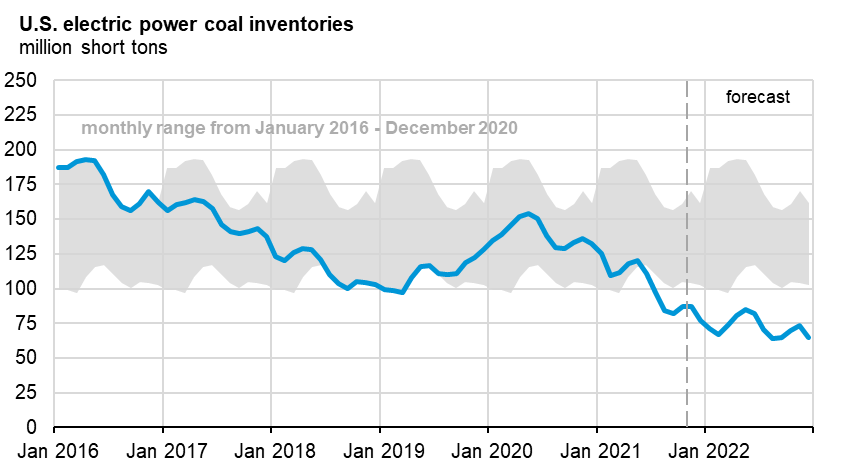Despite the United States having the largest coal reserves in the world—almost as much as China and India’s coal reserves combined—under the scrutiny of the Biden administration, utility companies are wondering whether they will have enough coal supplies to last the winter. Coal demand at electric utilities has risen due to increasing natural gas prices caused in part to Biden’s anti oil and gas policies. Now that coal is in demand, coal-fired power plants are struggling to replenish stockpiles because of post-COVID supply chain issues and because coal mines have closed as the Obama/Biden administration pursued its war on coal. Energy markets are facing shortages of transportation and labor, including truck drivers, railroad personnel, and coal miners.
Coal stockpiles, which in October stood at 87 million tons, are down 35 percent from a year ago, when 133 million tons were available going into winter. Current inventories are 18 percent below the lowest level in the past five years, and are projected to get as low as 65 million tons and not recover in 2022.
Declining Coal Stockpiles
Monthly coal stockpiles have fallen below the normal range, and are forecast to remain below normal through the end of 2022.

Due to low coal stockpiles at power plants, the regional electric grid operator, PJM Interconnection, has taken steps to prevent a system collapse this winter similar to the one in Texas in February. PJM imposed new rules on power plants in 13 states and the District of Columbia to make sure electricity generators do not run short of fuel during a cold snap. The rules would allow some coal generators to curtail operations to build up emergency reserves, increasing electricity prices, which are already rising.
Increasing energy prices this year have made coal more competitive. Federal energy officials estimate that coal power plants will generate about 160 billion kilowatt hours more electricity this year, a 21 percent increase from 2020. Coal’s share of the nation’s power mix is expected to increase from 19 percent last year to 23 percent this year.
While there is still plenty of coal in the ground in the United States, coal producers have been dis-incentivized by policy makers to invest, which would increase the reliability of the grid. Policy makers no longer seem to value reliability and resilience as they seek to add intermittent wind and solar power plants to the grid through mandates and subsidies. As such, the coal industry is wary about making the financial investments to ensure the supply chain remains healthy and able to provide reliable and resilient electricity. PJM attempted to address incentives with its temporary rules requiring coal generators to keep larger stockpiles on hand this winter. After the Polar Vortex of 2014, it also adopted “capacity performance” rules to pay power producers to winterize their plants and fuel supplies, and also enacted severe penalties on producers that failed to perform as promised.
American producers of coal, natural gas, oil, and propane are also facing increased demand for energy overseas, particularly in China and India. China’s still-expanding coal fleet of 1,080 gigawatts is as large as the entire U.S. electricity generation capacity combined, including gas, nuclear, renewables, petroleum and coal. China’s coal-power capacity is five times bigger than the U.S. coal fleet.
COP26 Hypocrisy
Achieving climate goals requires India and China, the largest and third largest emitters of greenhouse gases, to stop producing and using fossil fuels. But, both China and India have populations and economies that are pushing the demands on their power systems as they seek to break free from poverty. While these countries continue to use coal-fired power plants and to continue to build them, the Biden-Harris administration is expecting the American public to believe that they will eventually comply with their outstanding climate agreements. China’s premier has already indicated that it can change its commitments at will, and tear up its 2030 commitment to peak carbon dioxide emissions. Further, India had the language limiting coal energy in the draft COP26 agreement changed. India pushed the other nations to use terminology related to slowing coal power usage rather than deliberately transitioning away from it. These climate change deals are one-sided, unilateral agreements that nations break at will and with impunity.
Conclusion
The U.S. coal fleet supports grid reliability and resilience, helps keep electricity prices affordable, provides fuel security, and serves as an insurance policy when other electricity sources are not available or are too expensive. Yet, the Biden Administration wants to phase out all coal plants by 2035 when the President says the U.S. electricity grid should be carbon neutral. President Biden’s Climate Envoy, John Kerry, said the United States would not be using coal by 2030. It is clear to all bystanders that China and India will not comply with the aims of the U.S. and European leaders and instead recognize that they have growing populations and economies requiring more power and that all energy sources will be needed to continue their growth. European and U.S. policy makers need to wake up to the reality of what is happening around the globe lest they unilaterally disarm their nations’ economies and create unnecessary hardship for their people.



